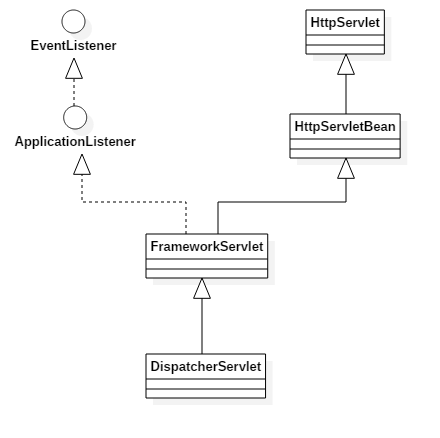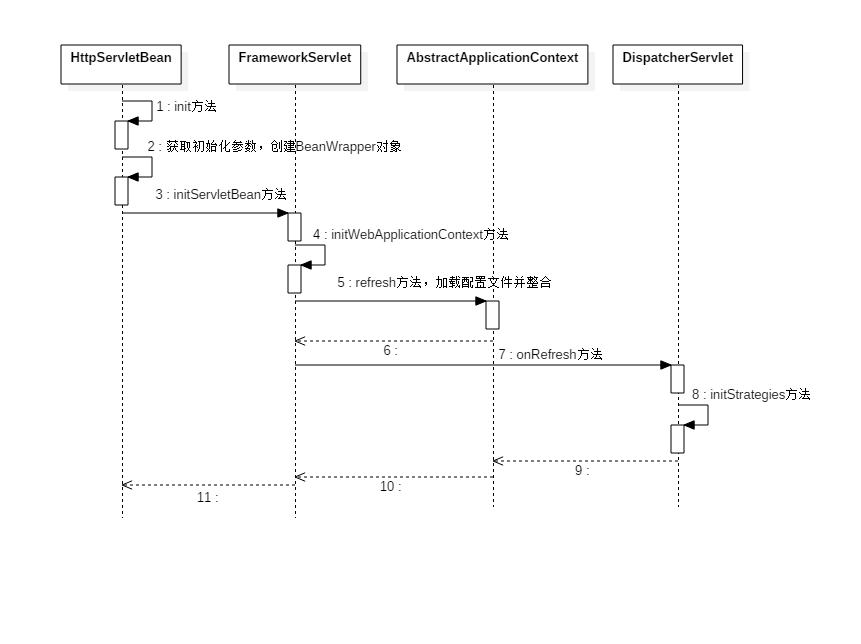【Spring MVC】DispatcherServlet詳解(容器初始化超詳細過程原始碼分析)
DispatcherServlet類相關的結構圖
DispatcherServlet的初始化程式
DispatcherServlet初始化了什麼,可以在其initStrategies()方法中知曉,這個方法如下:
protected void initStrategies(ApplicationContext context) { initMultipartResolver(context); initLocaleResolver(context); initThemeResolver(context); initHandlerMappings(context); initHandlerAdapters(context); initHandlerExceptionResolvers(context); initRequestToViewNameTranslator(context); initViewResolvers(context); initFlashMapManager(context); }
需要做的八件事情如下所述:
- initMultipartResolver:初始化MultipartResolver,用於處理檔案上傳服務,如果有檔案上傳,那麼就會將當前的HttpServletRequest包裝成DefaultMultipartHttpServletRequest,並且將每個上傳的內容封裝成CommonsMultipartFile物件。需要在dispatcherServlet-servlet.xml中配置檔案上傳解析器。
- initLocaleResolver:用於處理應用的國際化問題,本地化解析策略。
- initThemeResolver:用於定義一個主題。
- initHandlerMapping:用於定義請求對映關係。
- initHandlerAdapters:用於根據Handler的型別定義不同的處理規則。
- initHandlerExceptionResolvers:當Handler處理出錯後,會通過此將錯誤日誌記錄在log檔案中,預設實現類是SimpleMappingExceptionResolver。
- initRequestToViewNameTranslators:將指定的ViewName按照定義的RequestToViewNameTranslators替換成想要的格式。
- initViewResolvers:用於將View解析成頁面。
- initFlashMapManager:用於生成FlashMap管理器。
Spring MVC容器的初始化過程
首先,我們從web.xml中開始,在web.xml中我們首先配置的是contextLoaderListener,它的作用就是啟動web容器時,自動裝配ApplicationContext的配置資訊。因為它實現了ServletContextListener這個介面,在web.xml配置這個監聽器,啟動容器時,就會自動執行它實現的contextInitialized()方法。這樣就能夠在客戶端請求之前向ServletContext中新增任意的物件。
在ServletContextListener中的核心邏輯便是初始化WebApplicationContext例項並存放至ServletContext中。
public void contextInitialized(ServletContextEvent event) {
this.contextLoader = createContextLoader();
if (this.contextLoader == null) {
this.contextLoader = this;
}
this.contextLoader.initWebApplicationContext(event.getServletContext());
}這是ContextLoaderListener中的contextInitialized()方法,這裡主要是用initWebApplicationContext()方法來初始化WebApplicationContext。這裡涉及到一個常用類WebApplicationContext:它繼承自ApplicationContext,在ApplicationContext的基礎上又追加了一些特定於Web的操作及屬性。
這邊的操作就非常類似通過程式設計的方式使用Spring時使用ClassPathXmlApplicationContext類提供的功能。
public WebApplicationContext initWebApplicationContext(ServletContext servletContext) {
if (servletContext.getAttribute(WebApplicationContext.ROOT_WEB_APPLICATION_CONTEXT_ATTRIBUTE) != null) {
throw new IllegalStateException(
"Cannot initialize context because there is already a root application context present - " +
"check whether you have multiple ContextLoader* definitions in your web.xml!");
}
Log logger = LogFactory.getLog(ContextLoader.class);
servletContext.log("Initializing Spring root WebApplicationContext");
if (logger.isInfoEnabled()) {
logger.info("Root WebApplicationContext: initialization started");
}
long startTime = System.currentTimeMillis();
try {
// Store context in local instance variable, to guarantee that
// it is available on ServletContext shutdown.
if (this.context == null) {
this.context = createWebApplicationContext(servletContext);
}
if (this.context instanceof ConfigurableWebApplicationContext) {
configureAndRefreshWebApplicationContext((ConfigurableWebApplicationContext)this.context, servletContext);
}
servletContext.setAttribute(WebApplicationContext.ROOT_WEB_APPLICATION_CONTEXT_ATTRIBUTE, this.context);
ClassLoader ccl = Thread.currentThread().getContextClassLoader();
if (ccl == ContextLoader.class.getClassLoader()) {
currentContext = this.context;
}
else if (ccl != null) {
currentContextPerThread.put(ccl, this.context);
}
if (logger.isDebugEnabled()) {
logger.debug("Published root WebApplicationContext as ServletContext attribute with name [" +
WebApplicationContext.ROOT_WEB_APPLICATION_CONTEXT_ATTRIBUTE + "]");
}
if (logger.isInfoEnabled()) {
long elapsedTime = System.currentTimeMillis() - startTime;
logger.info("Root WebApplicationContext: initialization completed in " + elapsedTime + " ms");
}
return this.context;
}
catch (RuntimeException ex) {
logger.error("Context initialization failed", ex);
servletContext.setAttribute(WebApplicationContext.ROOT_WEB_APPLICATION_CONTEXT_ATTRIBUTE, ex);
throw ex;
}
catch (Error err) {
logger.error("Context initialization failed", err);
servletContext.setAttribute(WebApplicationContext.ROOT_WEB_APPLICATION_CONTEXT_ATTRIBUTE, err);
throw err;
}
}在initWebApplicationContext()方法中主要體現了WebApplicationContext例項的建立過程。首先,驗證WebApplicationContext的存在性,通過檢視ServletContext例項中是否有對應key的屬性驗證WebApplicationContext是否已經建立過例項。如果沒有通過createWebApplicationContext()方法來建立例項,並存放至ServletContext中。
protected WebApplicationContext createWebApplicationContext(ServletContext sc) {
Class<?> contextClass = determineContextClass(sc);
if (!ConfigurableWebApplicationContext.class.isAssignableFrom(contextClass)) {
throw new ApplicationContextException("Custom context class [" + contextClass.getName() +
"] is not of type [" + ConfigurableWebApplicationContext.class.getName() + "]");
}
ConfigurableWebApplicationContext wac =
(ConfigurableWebApplicationContext) BeanUtils.instantiateClass(contextClass);
return wac;
} protected Class<?> determineContextClass(ServletContext servletContext) {
String contextClassName = servletContext.getInitParameter(CONTEXT_CLASS_PARAM);
if (contextClassName != null) {
try {
return ClassUtils.forName(contextClassName, ClassUtils.getDefaultClassLoader());
}
catch (ClassNotFoundException ex) {
throw new ApplicationContextException(
"Failed to load custom context class [" + contextClassName + "]", ex);
}
}
else {
contextClassName = defaultStrategies.getProperty(WebApplicationContext.class.getName());
try {
return ClassUtils.forName(contextClassName, ContextLoader.class.getClassLoader());
}
catch (ClassNotFoundException ex) {
throw new ApplicationContextException(
"Failed to load default context class [" + contextClassName + "]", ex);
}
}
}determineContextClass()方法,通過defaultStrategies.getProperty()方法獲得實現類的名稱,而defaultStrategies是在ContextLoader類的靜態程式碼塊中賦值的。具體的途徑,則是讀取ContextLoader類的同目錄下的ContextLoader.properties屬性檔案來確定的。
也就是說,在初始化的過程中,程式會首先讀取ContextLoader類的同目錄下的屬性檔案ContextLoader.properties,並根據其中的配置提取將要實現WebApplicationContext介面的實現類,並根據這個類通過反射進行例項的建立。
綜合以上的程式碼,ContextLoaderListener監聽器的作用就是啟動Web容器時,自動裝配ApplicationContext的配置資訊。因為它實現了ServletContextListener這個介面,在web.xml配置了這個監聽器,啟動容器時,就會預設執行它實現的contextInitialized()方法初始化WebApplicationContext例項,並放入到ServletContext中。由於在ContextLoaderListener中關聯了ContextLoader這個類,所以整個載入配置過程由ContextLoader來完成。
diapatcherServlet的初始化過程
DispatcherServlet實現了Servlet介面的實現類。Servlet的生命週期分為3個階段:初始化、執行和銷燬。而其初始化階段可分為:
- Servlet容器載入Servlet類,把類的.class檔案中的資料讀到記憶體中;
- Servlet容器中建立一個ServletConfig物件。該物件中包含了Servlet的初始化配置資訊;
- Servlet容器建立一個Servlet物件;
- Servlet容器呼叫Servlet物件的init()方法進行初始化。
public final void init() throws ServletException {
if (logger.isDebugEnabled()) {
logger.debug("Initializing servlet '" + getServletName() + "'");
}
// Set bean properties from init parameters.
try {
PropertyValues pvs = new ServletConfigPropertyValues(getServletConfig(), this.requiredProperties);
BeanWrapper bw = PropertyAccessorFactory.forBeanPropertyAccess(this);
ResourceLoader resourceLoader = new ServletContextResourceLoader(getServletContext());
bw.registerCustomEditor(Resource.class, new ResourceEditor(resourceLoader, getEnvironment()));
initBeanWrapper(bw);
bw.setPropertyValues(pvs, true);
}
catch (BeansException ex) {
logger.error("Failed to set bean properties on servlet '" + getServletName() + "'", ex);
throw ex;
}
// Let subclasses do whatever initialization they like.
initServletBean();
if (logger.isDebugEnabled()) {
logger.debug("Servlet '" + getServletName() + "' configured successfully");
}
}init()方法中先通過ServletConfigPropertiesValues()方法對Servlet初始化引數進行封裝,然後再將這個Servlet轉換成一個BeanWrapper物件,從而能夠以spring的方式來對初始化引數的值進行注入。這些屬性如contextConfigLocation、namespace等等。同時註冊一個屬性編輯器,一旦在屬性注入的時候遇到Resource型別的屬性就會使用ResourceEditor去解析。再留一個initBeanWrapper(bw)方法給子類覆蓋,讓子類處真正執行BeanWrapper的屬性注入工作。但是HttpServletBean的子類FrameworkServlet和DispatcherServlet都沒有覆蓋其initBeanWrapper(bw)方法,所以建立的BeanWrapper物件沒有任何作用。
程式接著往下走,執行到了initServletBean()方法。在之前,ContextLoaderListener載入的時候已經建立了WebApplicationContext例項,而在這裡是對這個例項的進一步補充初始化。這個方法在HttpServletBean的子類FrameworkServlet中得到了重寫。
注:ContextLoaderListener載入的是除DispatcherServlet之外的其他的上下文配置檔案,而Spring MVC的配置檔案是在DispatcherServlet中設定的。
protected final void initServletBean() throws ServletException {
getServletContext().log("Initializing Spring FrameworkServlet '" + getServletName() + "'");
if (this.logger.isInfoEnabled()) {
this.logger.info("FrameworkServlet '" + getServletName() + "': initialization started");
}
long startTime = System.currentTimeMillis();
try {
this.webApplicationContext = initWebApplicationContext();
initFrameworkServlet();
}
catch (ServletException ex) {
this.logger.error("Context initialization failed", ex);
throw ex;
}
catch (RuntimeException ex) {
this.logger.error("Context initialization failed", ex);
throw ex;
}
if (this.logger.isInfoEnabled()) {
long elapsedTime = System.currentTimeMillis() - startTime;
this.logger.info("FrameworkServlet '" + getServletName() + "': initialization completed in " +
elapsedTime + " ms");
}
}在initServletBean()方法中,設計了一個計時器來統計初始化的執行時間,還提供了一個initFrameworkServlet()用於子類的覆蓋操作,而作為關鍵的初始化邏輯給了initWebApplicationContext()方法。
protected WebApplicationContext initWebApplicationContext() {
WebApplicationContext rootContext =
WebApplicationContextUtils.getWebApplicationContext(getServletContext());
WebApplicationContext wac = null;
if (this.webApplicationContext != null) {
// A context instance was injected at construction time -> use it
wac = this.webApplicationContext;
if (wac instanceof ConfigurableWebApplicationContext) {
ConfigurableWebApplicationContext cwac = (ConfigurableWebApplicationContext) wac;
if (!cwac.isActive()) {
// The context has not yet been refreshed -> provide services such as
// setting the parent context, setting the application context id, etc
if (cwac.getParent() == null) {
// The context instance was injected without an explicit parent -> set
// the root application context (if any; may be null) as the parent
cwac.setParent(rootContext);
}
configureAndRefreshWebApplicationContext(cwac);
}
}
}
if (wac == null) {
// No context instance was injected at construction time -> see if one
// has been registered in the servlet context. If one exists, it is assumed
// that the parent context (if any) has already been set and that the
// user has performed any initialization such as setting the context id
wac = findWebApplicationContext();
}
if (wac == null) {
// No context instance is defined for this servlet -> create a local one
wac = createWebApplicationContext(rootContext);
}
if (!this.refreshEventReceived) {
// Either the context is not a ConfigurableApplicationContext with refresh
// support or the context injected at construction time had already been
// refreshed -> trigger initial onRefresh manually here.
onRefresh(wac);
}
if (this.publishContext) {
// Publish the context as a servlet context attribute.
String attrName = getServletContextAttributeName();
getServletContext().setAttribute(attrName, wac);
if (this.logger.isDebugEnabled()) {
this.logger.debug("Published WebApplicationContext of servlet '" + getServletName() +
"' as ServletContext attribute with name [" + attrName + "]");
}
}
return wac;
}initWebApplicationContext()方法主要用於建立或重新整理WebApplicationContext例項,並對Servlet功能所使用的變數進行初始化。它獲得ContextLoaderListener中初始化的rootContext。再通過建構函式和Servlet的contextAttribute屬性查詢ServletContext來進行webApplicationContext例項的初始化,如果都不行,只能重新建立一個新的例項。最終都要執行configureAndRefreshWebApplicationContext()方法中的refresh()方法完成servlet中配置檔案的載入和與rootContext的整合。
再下來,重點來了:
if (!this.refreshEventReceived) {
// Either the context is not a ConfigurableApplicationContext with refresh
// support or the context injected at construction time had already been
// refreshed -> trigger initial onRefresh manually here.
onRefresh(wac);
}onRefresh(wac)方法是FrameworkServlet提供的模板方法,在其子類DispatcherServlet的onRefresh()方法中進行了重寫。而在onRefresh()方法中呼叫了initStrategies()方法來完成初始化工作,初始化Spring MVC的9個元件。
@Override
protected void onRefresh(ApplicationContext context) {
initStrategies(context);
}

